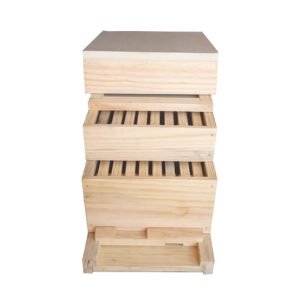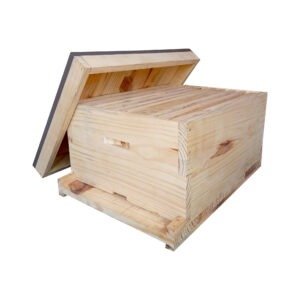A bee colony is a social structure consisting of thousands of individual bees living together as a single unit. Each colony comprises three main types of bees: the queen bee, worker bees, and drones. Here’s an overview of the roles and characteristics of each:
- Queen Bee:
- The queen bee is the reproductive female in the colony.
- She is larger than worker bees and has a longer abdomen.
- The primary role of the queen bee is to lay eggs, which are fertilized from mating flights she takes early in her life.
- The queen produces pheromones that regulate the behavior and development of other bees in the colony.
- There is typically only one queen bee in a colony, and her presence is crucial for colony survival.
- Worker Bees:
- Worker bees are sterile females responsible for various tasks within the colony.
- They perform duties such as foraging for food (nectar, pollen, water), caring for brood (eggs, larvae, pupae), building comb, and defending the hive.
- Worker bees transition through different roles in their lifetime, starting as nurse bees caring for brood, then progressing to roles such as foragers or guard bees.
- They communicate through complex dances and pheromones to share information about food sources and hive conditions.
- Worker bees have a relatively short lifespan, typically several weeks during the busy summer months.
- Drones:
- Drones are male bees with larger bodies, rounder eyes, and no stingers.
- Their primary role is to mate with virgin queens from other colonies during mating flights.
- Drones do not participate in hive maintenance, foraging, or brood care and are expelled from the hive during times of resource scarcity.
- They are produced in larger numbers during the spring and summer months when mating flights occur.
- Drones typically die after mating or are expelled from the hive before winter.
- Lifecycle and Behavior:
- The lifecycle of a bee colony begins with the queen laying eggs in the cells of the comb.
- Worker bees care for the developing brood by feeding larvae and maintaining hive temperature and humidity.
- Once mature, bees emerge from their cells and assume various roles within the colony.
- The colony functions as a highly organized society, with individual bees working together for the collective benefit of the colony.
Bee colonies play a crucial role in pollination, ecosystem health, and agriculture, making them essential to human food production and biodiversity. Beekeepers manage colonies for honey production, pollination services, and conservation efforts, helping to support bee populations and mitigate threats such as habitat loss, pesticides, and diseases.






Reviews
There are no reviews yet.